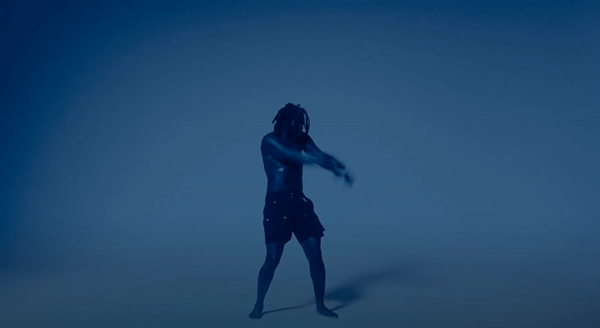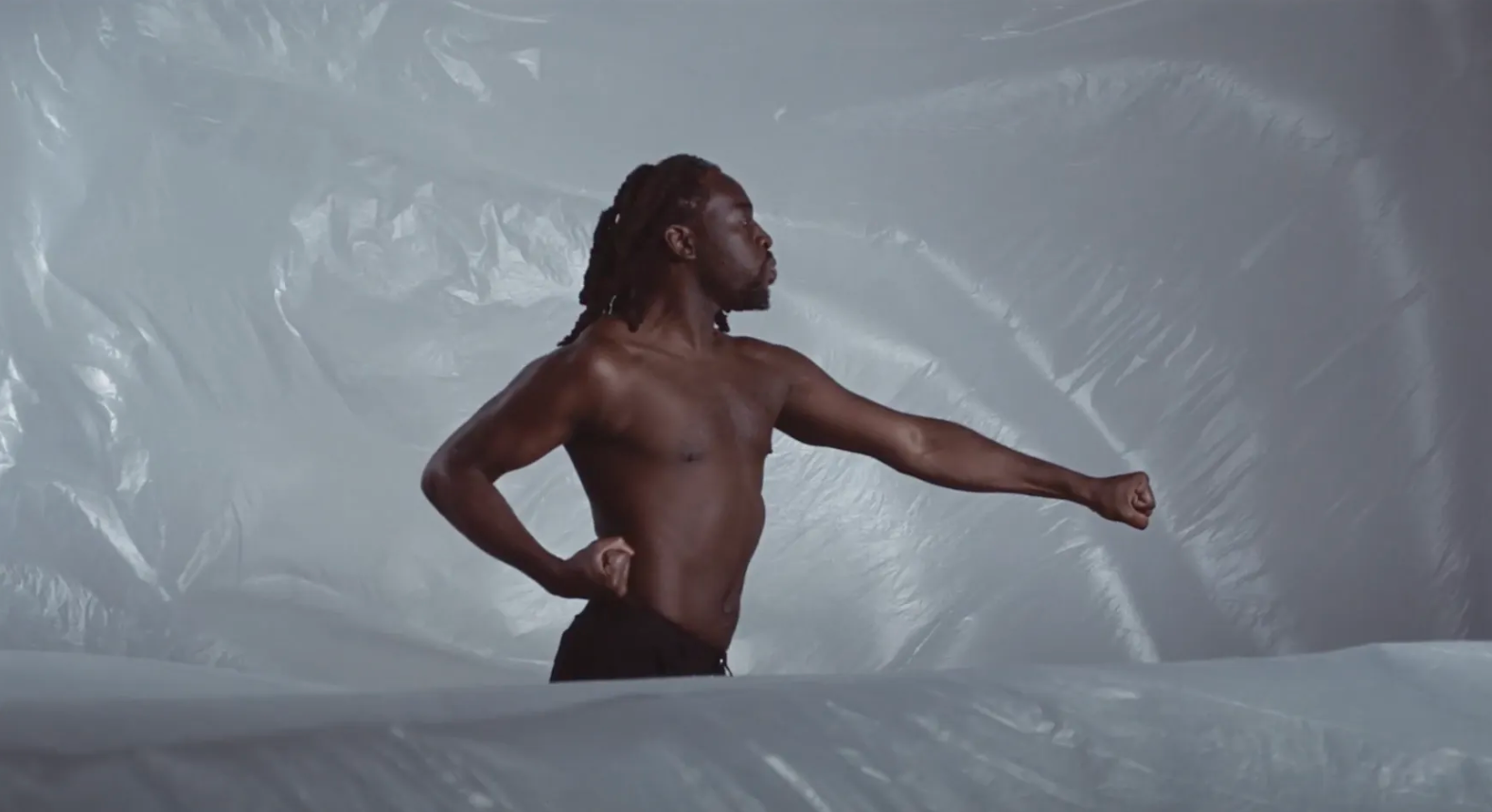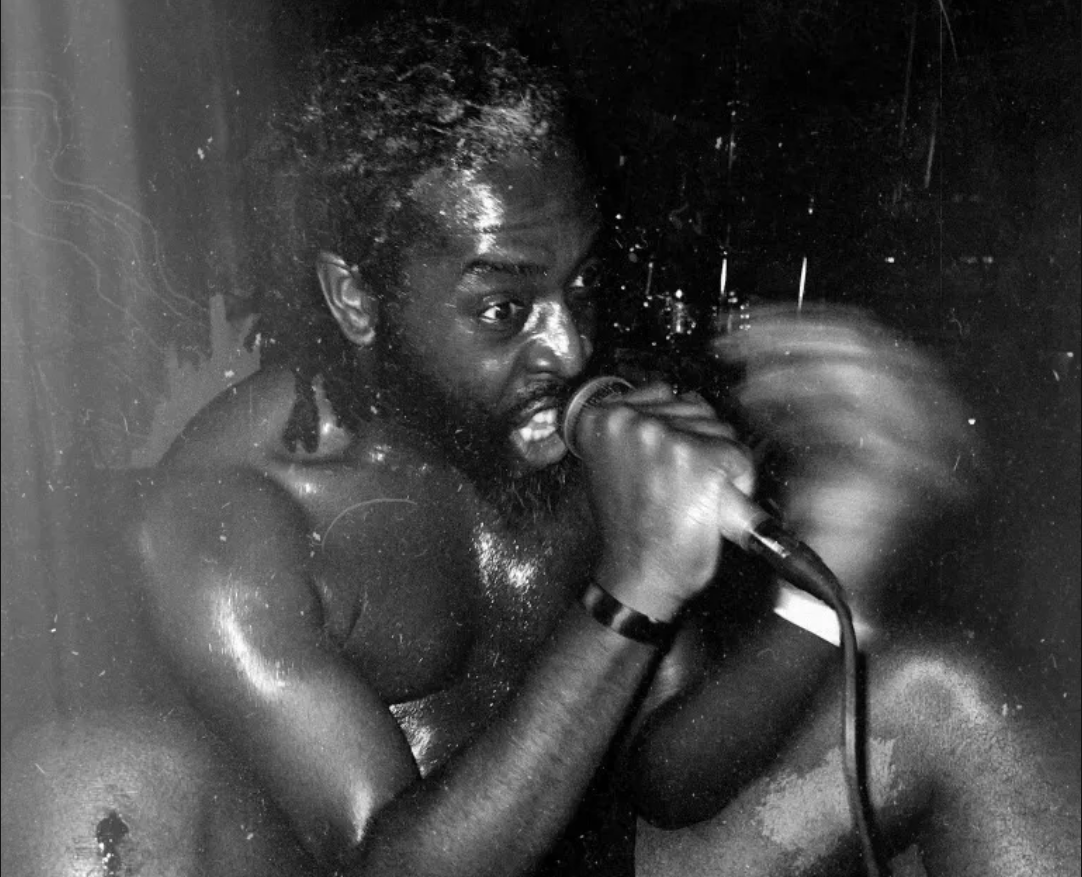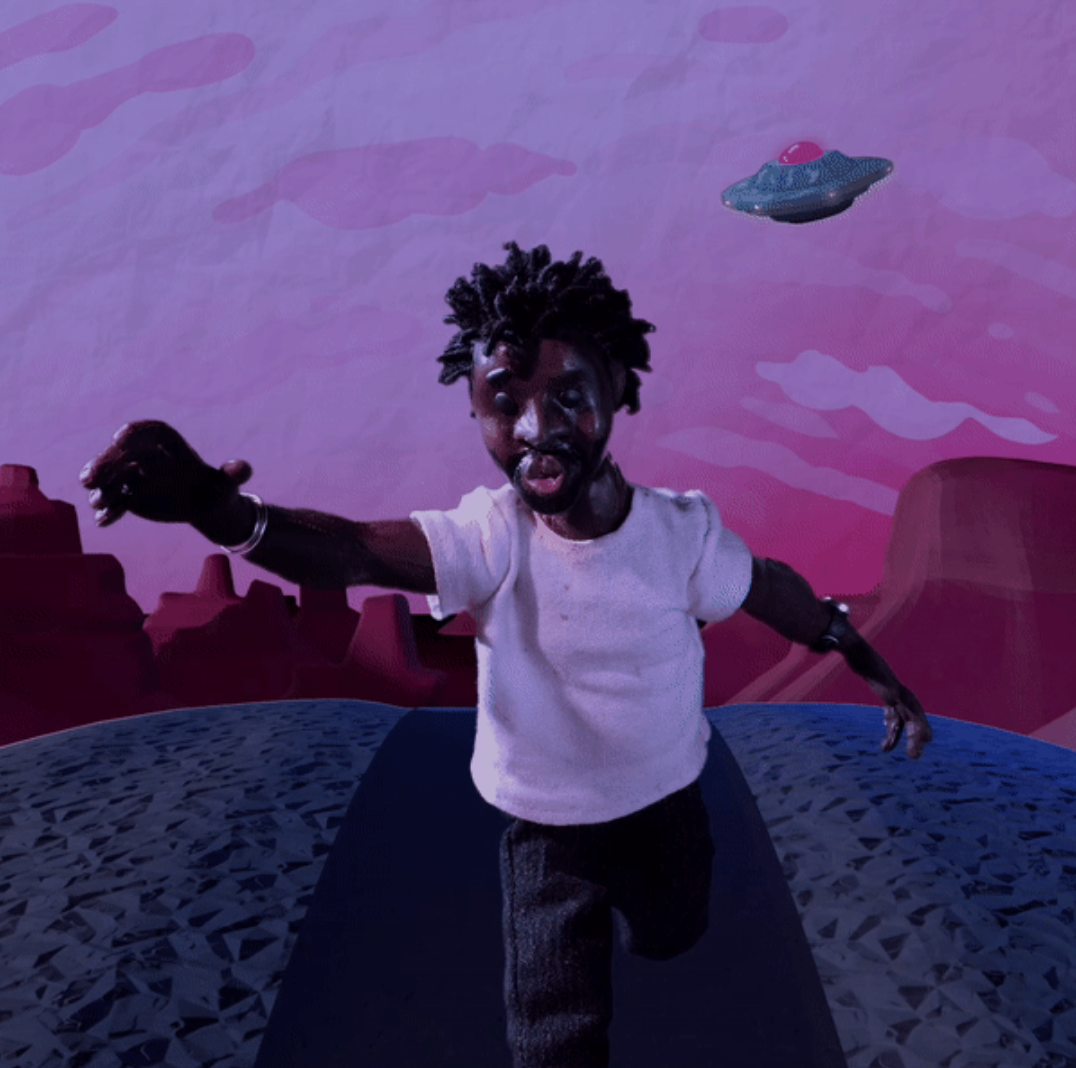The bravest imaginations must acknowledge f*cked shit from time to time. Even an artist capable of making this. And this. And this.
“Are you recording me? Are you the Feds? I’m in crypto and I’m Black so that’s two things the government don’t like.”
A half-grin wrinkles Ed Balloon’s cheek before he chuckles at his own quarter-joke. Survival tactics with a smile ㋡ I pinky promise our interview isn’t a sting op, though the Meta Ad Apparatus is certainly snooping. The sun illuminates the window blinds behind him, forming bars of light.
Outside, autumn has finally vanquished LA’s heatwaves, but Ed still feels burnout creeping. Calling out. Closing in. Even his side-projects have side-projects, at a time when most folks’ win columns are drier than Joshua Tree in a drought. As if Mercury chose chaos and made retrograde permanent.
“I think it’s really a God-given drive to have any chance with music,” he says. “Putting yourself in situations no one else would. Even now, yes it’s a bear market, but an artist’s default is struggling. We’ve all got that web2 trauma. We all have had those meetings where someone tells us they love our music, then they stop the compliments when they check the follower count. All these meetings, what’s the mother fucking result? It’s the game.”
Balloon has dug his heels in, much like so many artists who’ve only known hollow economics, predatory deal options, and a tattered blanket of a social safety net. Dreams remain, if not inflation-proof, crisis-resistant. Ed’s stop-motion short film will soon enter production. His clever audiovisual collection, Run Ed, demands consistent tender love & care, yielding 49 ETH and counting in total traded volume. Music, the well from which his ambitions rise, brings it all together. He’s done much of it on his own.
“As musicians, we’re so used to going to someone else for help, versus trying to build our own thing. That’s why it’s so easy for us to be owned and fucked over. You’ll think you need to drop on a given platform, then you get there and they don’t even care about music. They can’t even support your file size. When that happened to me, I was like, ‘I might as well drop this shit on OpenSea.’ Which is what I did, with the Run Ed collection. It’s like with web2. I know not to sign a 360. But if you’re 18 and trying to leave the trenches?”
Ed leaves the question unanswered. His independence, a small miracle, deserves recognition, but not romanticism. Ideally, no one would have to endure a world that pits music makers against success as if they’re twigs to a tank.

When artists take risks and stick the landing, listeners touch faith.
Like watching a trapezist stress-free. Or trusting a clutch player’s half-court shot.
They can convince our neurons, hungry for familiarity, to hold out for a new kind of rush. It’s a divine, if not religious, ear experience. Ed Balloon’s pulled off enough of those dice rolls at this point to deserve his own alt-pop denomination. The Dubs, his self-financed 2019 album, refused to tick musical boxes. Much of it still beams with ingenuity three years later.
https://deathbombarc.bandcamp.com/track/square-up-annieOn “Square Up Annie,” a glistening piece of motivator music, Ed casts a problems-be-gone spell (“one cup, two cups, three cups, too much”) over fast-break drums. If its soaring outro flirts with euphoria, “Saint,” another Dubs standout, ends in fireworks. Live drums and a brass melee roll into synths that jets skyward like an ultralight beam.
https://deathbombarc.bandcamp.com/track/saintAltogether, The Dubs has more twists than a who-dun-it. There’s the alien falsetto gliding across the surface of “Yankee” like its an icy exoplanet. “Edges” tries on candy-painted 80s drums, Neptunes bass lines, vocoders, and bright chords, courtesy of album co-creator David Chapman. The airy samples at the heart of “Hero,” an anti-cape anthem, evaporate as Balloon performs a few bars somewhere between The Purple One and contemporary R&B. “Rainbows” deploys a version of Ed who sings as if he’s leaking air for 20 spellbinding seconds. “Lost Boys” has its addictive second verse crunch from 0:45 to the 1:04 mark — a danceable micro-moment.
The artist’s 2021 EP, I Hate It Here, doesn’t disappoint either. With tweaking vocals and ghostly piano breakdowns, records like “I Need This Cash” and “Fiend” could have only come from one restless mind.

Rewind to 1999. West Texas, USA.
TLC’s FanMail has touched down from outer space. Their “No Scrubs” video glows on the screen of a TV as large as the minivan on good kid, m.A.A.d city’s cover. A young Edmund Oribhabor sits crosslegged, pupils glued. Chilli, T-Boz, and Left Eye beam into a metallic chamber, busters and broke asses light years beneath them. From that point on, his appreciation for visuals never wavered.
“Suddenly, I felt this need to always see a music video,” Balloon remembers. “We didn’t have cable in the house, but every Saturday we could see the newest ones. That was before moving back north. I was listening to music every day. My sister was a huge fan of Tupac, Brandy, Monica, and TLC. My dad played everything from Barry White to the Beatles to Prince to Fela Kuti. We came up going to Nigerian parties, before it was cool to know Nigerian music in America.”
Balloon grew up in Roxbury — a historic, sometimes notorious Boston enclave that New Edition, Malcolm X, and Guru of Gang Starr once called home — but spent long stretches in the Lone Star state with his uncle. Ed’s father, a Nigerian immigrant, had to maximize his hours behind the wheel while driving a taxi on the east coast. (Mr. Oribhabor eventually saved up enough money to purchase his taxi medallion last year.)
When the time came to reunite, Ed traveled back to Roxbury’s Mandela Projects. Open-invite cookouts brought folks together. Neighbors kept an eye out for each other during blizzard season. Soon enough, Ed and his siblings turned other kids on the playground into bandmates. In the absence of proper drum sticks, clothing hangars loudly tapped against floorboards did the trick.
“I was nine years old when we made a demo and sent it to a label executive. No mic. We performed directly into a cassette recorder,” Ed says, laughing. “It got returned to us in the mail. We may have put the wrong address down, but thank God, with how our voices sounded back then. I miss those days. Being able to walk everywhere, to Fenway or across the bridge to Cambridge. This was back when if you saw a white person, you knew they were in the wrong place.”
Like so many historically Black neighborhoods across the country, much has changed since those days.
“Now there’s hotels and Northeastern University students. The barbershop everyone went to, that’s gone. Izzy’s corner store got bought up and redone. My friend walked in there the other day and she said they looked at her like she didn’t belong. Ultimately I’m just happy my homies from back then are good, but the Black soul isn’t the same.”

Around the time Ed & friends tried to send off that first demo tape to a label A&R, record companies tossed law suits around like meatballs in a food fight.
In 2001, buckling under an RIAA onslaught, Napster shuttered. Then, in 2003, the RIAA started targeting everyday listeners for pirating files online. Balloon, not yet a teenager, read the tea leaves: IP mattered, and with that, original art. He started mimicking songs that caught his ear and twisted them beyond recognition. That early defense mechanism evolved into the kind of musical instinct you can’t teach a person — or algorithm — to conjure. Anything less than a challenge made him feel stagnant.
While legal whack-a-moles convinced Balloon to explore new song structures, he couldn’t shake the early aughts pressure to become a vocal soundalike. The male pop sweet spot of the era (aka the Usher zone) (aka tenors with silky soft falsettos) forced Ed, a bass baritone, to double down on himself, though not before contorting his natural range for much of his adolescence. The constant strain damaged his larynx, but when he sought out medical attention, a throat specialist tragically overcorrected. The doctor performed needless surgery on the artist. He told Ed to expect a four-month recovery. It took three years to get back to square one.
“That was traumatizing,” he tells me, looking away. “In that first year, I could barely speak. Even in that third year, it’s still not my voice. And my reality made things worse. Some people have the privilege of staying home on voice rest, but I’m this dude from the projects. I have to work. I have to talk, even when I barely can. I went to a prestigious school. I didn’t expect to work as a cashier, but there I was, post-graduation, needing to talk, fatigued.”
Fighting through daily pain, Ed refused to get complacent. He penned countless records during that quieter era, humming them into memory. Envisioning a future for himself few others could. Mr. Oribhabor, when informed of his son’s decision to double down on artistry, warned him of a life of poverty.

Fast forward to 2015.
Michael Christmas and Cousin Stizz are starting to bring national attention (and Drake remix rumors) to Boston’s music scene. Ed’s working the graveyard shift as a mental health worker in the city. After logging all nighter hours, he rides the T’s green line to the suburbs in the a.m., where a performance troupe, Commonwealth Shakespeare, gathers. (The program, initially slated to take place within Boston, inevitably set up shop in the wealth-concentrated outskirts. A similar power dynamic drives the METCO program, which busses predominantly Black youth to predominantly white school systems, never the inverse.)
Exhausted, Ed sticks with it. There he meets Paul, a supportive vocal coach, and the sleepless metro treks start to pay off. They use Linklater’s Freeing the Natural Voice as a guide to help Ed project beyond his throaty vocal fry, hitting upper notes for the first time since his surgery. Less lip frills, more deep exhales. It takes 12 months to correct course. Then comes the search for a collaborator, and Ed once again finds himself looking in from the outside.
“I didn’t sound like anyone else, for better and for worse. A lot of producers didn’t know what to do with me. It was even a struggle to find beats on YouTube that worked with my range. I’ll never forget my cousin, who was a ball player, telling me, ‘I have a better chance of making it to the league than you have at being a singer.’ You start to ask yourself, ‘Why am I making music like this?’ But your body won’t allow you to compromise.”
After false starts with producers at more costly studios, Balloon saves enough money from his day job — $500 for an eight-hour session — to try a less glamorous space in Brighton. That’s when he and producer David Chapman cross paths.
“I remember pulling up and the dude that opened the door was my age with a motorcycle jacket and a fucking mullet,” Ed says, grinning. “That was Dave. Ready to try new shit. Willing to make weird music with me. He’s my bandmate and friend to this day. He was the first person to hear my real voice post-surgery and tell me, ‘You can really sing.’”
The new friends got to work. The devil kept their pace. Ed, a dark-skinned Black man leading an otherwise white band, encountered reluctance from bookers. Despite receiving screams for an encore following their opening set for a noise act at Brighton Music Hall, the band never received an invite to return. He wanted to play music for “the zombie alternative type.” But the alt venues wrote him off as a hip-hop act. Meanwhile, the rap heads considered him an outcast, shocked when he refused to perform without instruments. The few bookers who did express interest wound up going ghost. Hungry for more opportunities, Balloon flew the coup. Los Angeles had his number.
“I was stressing about leaving,” he says. “How do I find a job? I was helping my mom pay rent — how will she manage? How do I tell people I’m going? This was in the winter. I remember filing papers while working at Tufts Medical Center, crying, singing what would become my song ‘Hero.’ I was sick of the TV telling me about heroes all the time. I was sick of these fairy tales. Then a friend of mine said to me, ‘If you don’t move to LA, you’re a bitch.’ I was like, ‘Okay! That’s it.’ And we left.”
Dave and Ed drove 3000 miles only to learn their housing situation had fallen through. Ed spent the next four months couch surfing or paying for Airbnbs; every dime he had went to keeping a roof over his head or Ubering to Santa Monica, where Dave had found work at a local studio. Ed’s album The Dubs emerged from those cross-town rendezvous. The day-to-day hustle was — and remains — prophesied. Not long before he left Boston, Ed recorded this: “It’s a dream world / and dreams don’t pay the bills / so I’m gon’ hit this flight / and go take what’s real.”

These days, mixed reality keeps the landlord away.
In April, Balloon pushed himself even further with Run Ed. The 1000-piece collection presents audiovisual variations of the same scored nightmare: pursuit. When comets, villainous planes, or birds of prey aren’t circling overhead, Ed sprints through chilling serenity as an unseen force chases him in broad daylight. The artist stars in the series as an action figure — the same character who’s appeared on Catalog and beyond.
“The puppet is made of silicon,” Ed tells us. “Close to real, but not. I could see something that’s almost me, doing these gestures, without being fully human. I had a script for a short film, so we decided to use this as a way of raising money to produce it and showcase my art at the same time.”
Ed’s rollout, a mega-success by any traditional metric for an independent artist during a global financial meltdown, still caught some ire from Twitter fingers. Some collectors, hunting for financial returns, expected more. It’s a reminder of the unresolved tensions between web3 music’s focus on collective, mutual support for art and its creators, versus the broader libertarian streaks common across crypto.
“We wanted to sell 5,000 at first and had to lower that to 1,000, which we sold out of, and that still gave us what we needed to pilot the film, but it was really hard. I felt like I let people down in a public way. For awhile, it was like, how do I come back from this?”
The quality of his work and his altruism helped. Ed, always looking out for others, didn’t stop at self-funding. He’ll only use 50% of the 10s of 1000s in USD he generated for that. The other half will support other underrepresented artists releasing on-chain. He encourages anyone rolling out records they treasure in web-whatever to know their worth: “Music is cheap to consume, but it’s not cheap to make. We have a chance to fix that. Artists are actually working together in this space, talking to devs, ”
As for the fate of Run Ed’s character?
Each clip ends with a cliffhanger.
https://beta.catalog.works/ed-balloon/guys-take-t-o-long-to-make-f-kin-decisions-man


